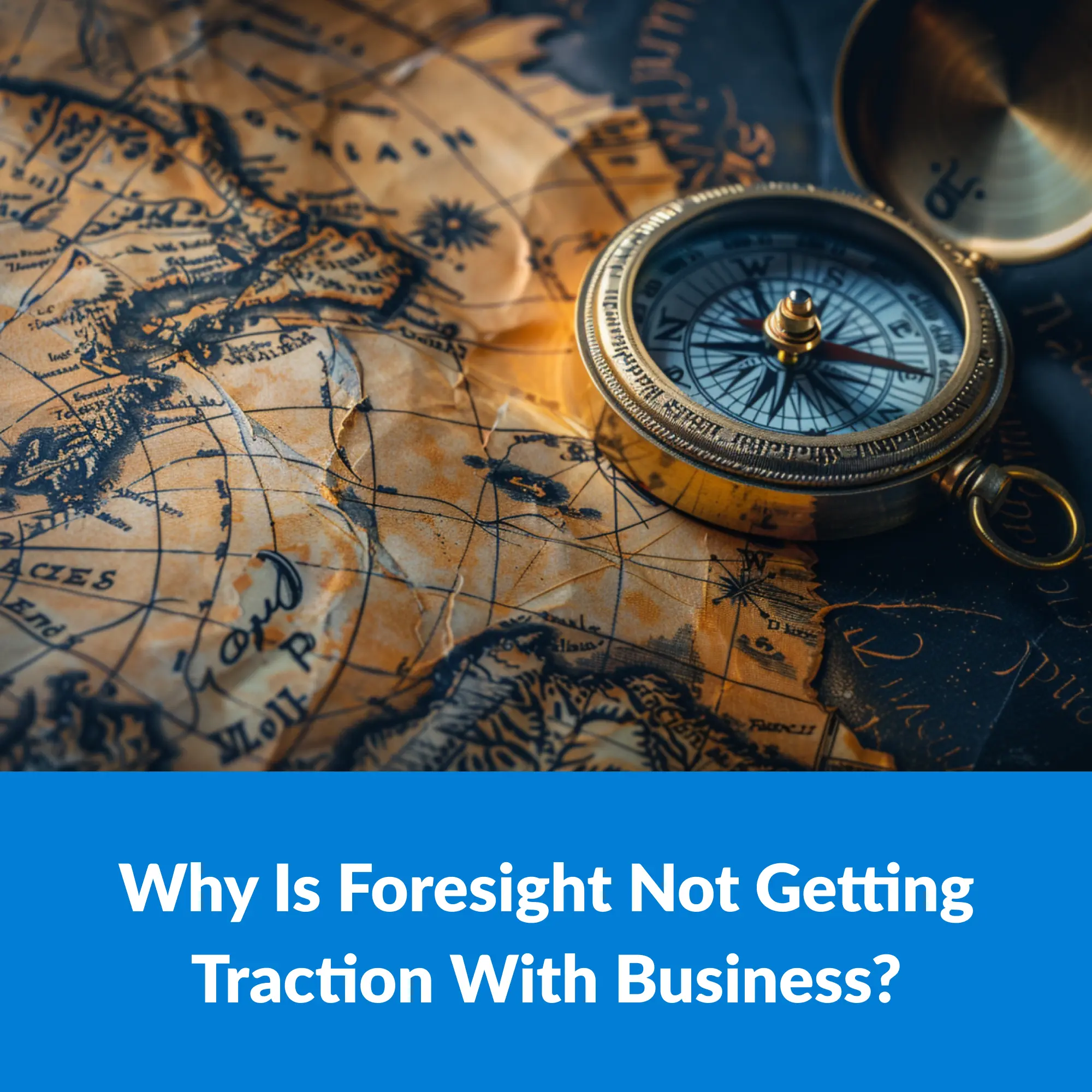Imagine a company, a leader in its industry for decades, gets blindsided by a technological shift and crumbles within a year. Sound like a scene from a dystopian movie? It’s not. This scenario plays out all too often in the real world and the culprit? A lack of foresight.
In the rapidly changing business environment, foresight— the ability to anticipate and prepare for future challenges and opportunities—is a crucial element for long-term success. However, despite its significance, foresight often struggles to find a place in mainstream business strategies. This article explores the barriers to its adoption and suggests ways to integrate foresight more effectively into business planning.
Preface: This article diverges from our usual focus on
Epilogue Opus, our digital adoption platform. We occasionally like to explore diverse subjects to provide interesting insights and perspectives. We appreciate your readership.
Understanding Foresight
Foresight involves a systematic, participatory process focusing on long-term thinking to inform present decisions and mobilize joint actions. Unlike traditional forecasting, which often extrapolates past and present trends, foresight involves qualitative methods and scenario planning to explore possible futures. Businesses use foresight to preemptively shape their strategies rather than being reactionary to market forces.
The Importance of Foresight in Business Strategy
Foresight serves as the compass, guiding businesses through the ever-changing landscape of markets, technologies, and consumer behaviors. In an era marked by unprecedented disruption and uncertainty, the ability to anticipate and prepare for future challenges is paramount. Foresight enables organizations to go beyond reactive, short-term decision-making and adopt a proactive, long-term perspective.
By systematically analyzing trends, drivers of change, and potential scenarios, businesses can identify emerging opportunities and threats before they fully materialize. This proactive approach allows companies to adapt their strategies in advance, minimizing the impact of disruptions and positioning themselves for sustainable growth.
Moreover, foresight empowers businesses to challenge conventional wisdom and explore alternative futures. By envisioning different scenarios and their implications, organizations can test the robustness of their strategies and identify potential blind spots. This process of strategic foresight fosters innovation and creativity within organizations, encouraging leaders to think beyond the status quo and embrace change as a source of competitive advantage.
Additionally, foresight enhances strategic resilience by building adaptive capacity and flexibility into business operations. By continuously scanning the external environment and monitoring key indicators, businesses can detect early warning signals of market shifts or industry disruptions.
This early awareness allows companies to proactively adjust their strategies, reallocate resources, and pivot their business models to stay ahead of the curve. In essence, foresight equips businesses with the agility and resilience needed to thrive in an uncertain and volatile business landscape.
Furthermore, foresight plays a critical role in stakeholder management and relationship building. By engaging with customers, suppliers, industry experts, and other stakeholders in the foresight process, businesses can gain valuable insights and perspectives that inform strategic decision-making. This collaborative approach not only strengthens relationships but also fosters a shared sense of purpose and commitment towards achieving common goals.
So why is foresight not getting traction with business: Challenges to Adoption
1. Lack of Awareness and Understanding
A significant barrier to the adoption of foresight in business is the general lack of awareness and understanding among business leaders. Many executives and managers are not familiar with the concept of foresight, mistaking it for simple trend analysis or traditional forecasting.
This misunderstanding stems from a lack of exposure to foresight methodologies in conventional business education, which often emphasizes quantitative techniques and immediate problem-solving skills. To bridge this gap, it is crucial to introduce foresight as part of executive training and MBA programs, highlighting its distinct approach and benefits over traditional methods.
2. Cultural Resistance
Organizational culture plays a pivotal role in the adoption of new practices, including foresight. Many businesses operate within cultures that prioritize short-term achievements and immediate financial results, such as quarterly profits and annual growth targets. This short-term focus can create resistance to investing time and resources in long-term planning activities that do not provide immediate financial benefits.
For foresight to take root, there needs to be a cultural shift towards valuing long-term success and sustainability. This shift requires deliberate efforts from top management to redefine success metrics and encourage a forward-thinking mindset among all employees.
3. Resource Constraints
Resource allocation is another critical challenge, especially in smaller and medium-sized enterprises where budget and personnel are limited. These companies often find it difficult to justify the allocation of scarce resources to activities like foresight, which do not guarantee immediate returns.
The perception that foresight is a luxury rather than a necessity prevails in environments where day-to-day operations consume most of the resources. Overcoming this challenge involves demonstrating the potential return on investment from foresight activities through case studies and evidence from companies that have successfully implemented foresight strategies.
4. Perceived Complexity
The perceived complexity of implementing foresight strategies can also deter businesses from adopting them. Foresight involves various methodologies such as scenario planning, environmental scanning, and the Delphi method, which can be daunting for those without prior experience. This complexity can be particularly overwhelming when businesses do not have dedicated teams to handle strategic planning.
Simplifying the initial steps of foresight, such as starting with basic trend analysis and gradually advancing to more complex scenarios, can help ease businesses into the practice. Additionally, providing tools and frameworks that demystify these methodologies can encourage more organizations to adopt foresight.
Strategies to Enhance Foresight Adoption
1. Education and Training
One of the most effective ways to overcome the challenges of foresight adoption is through education and training. Businesses can offer workshops, seminars, and online courses to educate their leaders and employees about the importance and methodologies of foresight.
These training sessions should not only cover the theoretical aspects of foresight but also provide practical examples and case studies demonstrating its real-world applications. Additionally, integrating foresight modules into existing leadership development programs and MBA curricula can ensure that future business leaders are equipped with the necessary skills to incorporate foresight into strategic decision-making.
2. Integration with Existing Processes
Foresight should not be treated as a standalone activity but rather integrated into existing strategic planning processes. By aligning foresight activities with ongoing strategic initiatives, businesses can ensure that foresight is not seen as an isolated endeavor but as an integral part of their overall strategy.
This integration involves incorporating foresight methodologies into regular planning cycles, such as annual strategic reviews and budgeting processes. Furthermore, establishing cross-functional teams responsible for both short-term operational planning and long-term foresight can facilitate seamless integration and collaboration across different departments.
3. Leadership and Advocacy
Leadership plays a crucial role in driving foresight adoption within organizations. Top management must champion foresight initiatives and actively advocate for their implementation across all levels of the organization. By visibly endorsing foresight and incorporating its practices into their decision-making processes, leaders can set an example for their teams and instil a culture of forward-thinking within the organization.
Furthermore, appointing dedicated foresight champions or establishing a foresight task force can provide the necessary leadership and momentum to drive foresight initiatives forward.
4. Pilot Projects and Proof of Concept
To demonstrate the value of foresight and alleviate concerns about its feasibility, businesses can initiate pilot projects or proof-of-concept studies. These smaller-scale initiatives allow organizations to test foresight methodologies in a controlled environment and evaluate their effectiveness before committing to larger-scale implementation.
Pilot projects can focus on specific business units, product lines, or geographic regions, providing tangible results and insights that can be used to garner support for broader adoption. Additionally, showcasing success stories and lessons learned from pilot projects can help overcome skepticism and build confidence in the potential benefits of foresight.
5. Collaboration and Knowledge Sharing
Collaboration and knowledge sharing are essential for fostering a culture of foresight within organizations. Businesses can leverage internal networks and platforms to facilitate collaboration among different departments and teams, enabling the exchange of ideas, insights, and best practices related to foresight.
Furthermore, establishing partnerships with external stakeholders, such as industry associations, academic institutions, and consulting firms, can provide access to additional expertise and resources to support foresight initiatives. By creating a collaborative ecosystem focused on foresight, businesses can leverage collective intelligence and stay ahead of emerging trends and challenges.
In Conclustion
The slow adoption of foresight in business circles can be attributed to various factors, including cultural resistance, resource constraints, and a lack of understanding. By addressing these challenges through education, strategic integration, and leadership advocacy, businesses can better prepare for the future, ensuring their longevity and success in an ever-changing global market.











